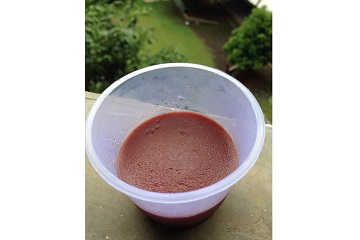The Student of IPB Successfully Produced Cholesterol-Lowering Snack

Lifestyle is a way used by people, groups and nations and is formed in specific geographical, economic, political, cultural and religious text. Lifestyle is referred to the characteristics of inhabitants of a region in special time and place. It includes day to day behaviours and functions of individuals in job, activities, fun and diet. Today, wide changes have occurred in life of all people. The more you change your lifestyle to ensure a healthy mind and body, the more you'll be able to cope with the challenges of depression. However, lifestyle changes such as lack of exercise, eating too many foods containing cholesterol and fat, and lack of fiber intake can lead to disease. Lack of exercise is a major cause of chronic diseases, such as cardiovascular diseases. The key risk factors for coronary heart disease (CHD) such as hypercholesterolemia, diabetes mellitus, and obesity are likely to increase in the future.
Efforts to reduce hypercholesterolemia is by eating high-fiber foods, because high-fiber foods can help guard against cancer, heart disease, diverticulosis, kidney stones, PMS, obesity and help support a healthy digestive tract. Hypercholesterolemia means that you have high levels of cholesterol in your blood. High cholesterol levels can lead to clogged arteries, heart disease, and heart attacks. A healthy diet rich in high-fiber foods and the “good” fats, polyunsaturated and monounsaturated fats, can also help lower your cholesterol levels. One effort made to reduce hypercholesterolemia is by eating foods that contain high in fiber. High-fiber foods can help us meet fiber needs and so much more. To be a “high-fiber” food, the product must contain at least 6 g of fiber per 100 g of a product or at least 3 g of fiber per 100 calories. Beans are among our best choices for fiber-rich foods. Beans contain a number of non-nutrient physiologically active compounds (phytochemicals), including simple phenolics, especially flavonoids (phytoestrogens and catechins), polyphenols (tannins), phytates, saponins, alkaloids and sterols. Many of these compounds have been reported to be able to reduce the growth of different types of cancer cells and to lower cholesterol levels.
Accordingly, the student of the Department of Food Science and Technology, of the Faculty of Agricultural Technology of Bogor Agricultural University (FATETA IPB), Ditha Mithania, conducted research program to utilize rice bran and angkak, to be added into agar as a cholesterol-lowering snack.
Eating jelly, which contains gelatine, can be beneficial; gelatine can boost the immune system and keep your heart healthy. It is one of the most favored snack foods in Indonesia because it riches in fiber content. Fiber is something the body needs but never actually digests, in fact, it remains more or less the same from plate to toilet. However, Ditha has an innovation by adding rice bran and cassava on gelatin so that it can be a more functional snack alternative.
Rice bran is a by-product of the rice milling process, and it contains over 200 antioxidants, phytosterols and phytochemicals that impart supportive effects on human health. Bran is particularly rich in dietary fiber and fatty acids and contains significant quantities of starch, protein (balanced amino acid profile), vitamins (rich in B complex), and dietary minerals. It constitutes a store house of micro-nutrients low or short in the modern diet. Bran is a rice mill waste that contains fiber. In addition to rice bran, Angkak is a rice fermented by mold. Bran and Angkak contain phytochemical compounds that can lower cholesterol, including saponins, tannins, alkaloids, flavonoids and phenolics.
The study carried out Ditha was consisted of stages. The first stage was to test tannins and alkaloids on water fraction of rice bran and Angkak. Then the process of gelatin production, chemical characterization and physical properties of gelatin product. Chemical characteristics include proximate analysis, fiber content, total phenolic and flavonoid test, and in vitro binding of cholesterol. While physical characteristics include test organoleptik hedonic ratings, color analysis and texture.
Three formulas were tested on the preparation of agar, by adding sodium citrate by 0.1%, 0.3%, and 0.2%. The results showed that the formula with 0.3% of sodium citrate was most preferable, particularly with the addition of rice bran and angkak by 3.99% and 0.11%, respectively of the total weight of the product.
The selected agar product contains 14.80 percent of food fiber and a total flavonoid of 2mg per 100 grams of product. The experiment showed that cholesterol "binding" of these fiber inclusions in vitro. Gelatin can lower cholesterol by 60.11% (dry basis). The gelatin product is brownish red and this product is softer if compared with the one without the addition of rice bran and red yeast. (Wies)



